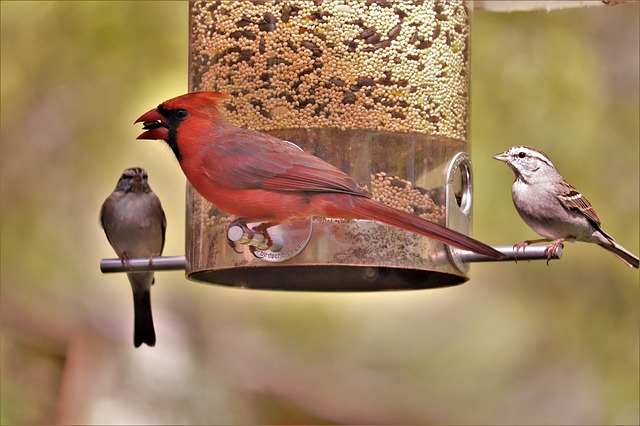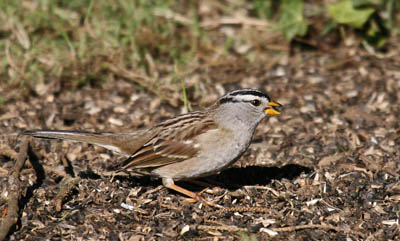Feeding birds on the ground is a simple and cost-effective way to attract a variety of backyard birds. It mimics the natural behavior of birds finding seeds on the ground and can be especially appealing to species like sparrows, towhees, doves, and blackbirds. While it may create some challenges, such as messiness, potential pests, and hiding spots for cats, there are ways to mitigate these issues. Bird seed can be placed on bare soil, the crust of snow, cement sidewalks, or patios. Additionally, low platform feeders can be used, which offer better seed control and attract a wider range of avian visitors. It is important to choose the appropriate seeds, such as black oil sunflower seeds, red milo, cracked corn, and white proso millet. Considering bird feeder placement and how to see the birds from inside your home are important factors to consider when implementing this ground feeding method.
Feeding Birds on the Ground: A Simple and Inexpensive Method

Introduction
Feeding birds is a popular activity that brings joy and beauty to any backyard. It not only provides essential nourishment for our feathered friends, but also allows us to observe their fascinating behaviors up close. While there are various ways to feed birds, one simple and inexpensive method is by throwing bird seed on the ground. This article will explore the benefits, common backyard birds that feed on the ground, as well as the challenges and strategies involved in feeding birds on the ground.
Benefits of Feeding Birds on the Ground
When it comes to bird feeding, many people automatically think of hanging feeders. However, feeding birds on the ground offers several advantages that make it an attractive option for bird enthusiasts.
Natural Feeding Behavior
Many birds prefer feeding on the ground, as they are accustomed to finding seeds and insects on the forest floor or open meadows in their natural habitat. By providing a ground feeding area, you are mimicking their natural feeding behavior and attracting a wider variety of bird species to your yard.
Attracting a Variety of Birds
Feeding birds on the ground can attract a diverse range of backyard birds. Common species in the United States that frequently feed on the ground include sparrows, towhees, doves, blackbirds, and many more. These birds bring color, song, and charm to any outdoor space, enhancing the overall birdwatching experience.
Cost-effective and Sustainable
One of the major advantages of feeding birds on the ground is its affordability. Simply scattering bird seed on the ground is much cheaper than purchasing specialized bird feeders. Additionally, this method creates less waste, as birds have direct access to the seeds without the need for feeders that may accidentally spill or become contaminated.
Common Backyard Birds that Feed on the Ground
When setting up a ground feeding area, it’s important to know the birds that are likely to visit. Here are some common backyard birds in the United States that frequently feed on the ground:
Sparrows
Sparrows, such as the House Sparrow and the White-crowned Sparrow, are known for their affinity for ground feeding. They can often be seen hopping and scratching around in search of seeds and insects.
Towhees
Towhees, like the Eastern Towhee and Spotted Towhee, are ground-dwelling birds that are likely to visit your yard if you provide a suitable feeding area. Their distinctive scratching behavior makes them easy to spot.
Doves
Doves, such as the Mourning Dove and the Eurasian Collared-Dove, are often seen on the ground, foraging for seeds. They have a gentle and peaceful presence that can add tranquility to your outdoor space.
Blackbirds
Blackbirds, including Red-winged Blackbirds and Common Grackles, are commonly found in flocks on the ground, searching for food. Their glossy black feathers and melodic calls make them a delight to observe.
Problems and Challenges of Feeding Birds on the Ground
While feeding birds on the ground has numerous benefits, it also comes with its fair share of challenges. It’s important to be aware of these potential issues and take necessary precautions to overcome them.
Messiness
One of the main concerns with ground feeding is the mess it can create. Seeds scattered on the ground may attract squirrels and other small mammals, which can lead to debris and shell fragments littering your outdoor space.
Potential Pests
Feeding birds on the ground can also attract unwanted guests such as rats, mice, and raccoons. These pests can cause damage to your property or pose a threat to the birds themselves.
Hiding Spots for Cats
Ground feeding can inadvertently provide hiding spots for predatory cats. It’s crucial to be mindful of the safety of the birds and take precautions to prevent cat predation.
Strategies to Overcome Challenges
To address the challenges associated with feeding birds on the ground, there are several strategies you can employ. Regular cleaning of the feeding area, using squirrel-proof feeders, and placing barriers to discourage pests are effective ways to maintain cleanliness and prevent unwanted visitors. Additionally, providing open and unobstructed views of the feeding area can help monitor for potential dangers.

Choosing the Right Location
When implementing ground feeding, choosing the right location is key to attracting birds and ensuring their safety. Here are some suitable areas to put bird seed on the ground:
Bare Soil
An area of bare soil in your yard can serve as a natural ground feeding spot. Birds can easily scratch and peck at the seeds, mimicking their natural foraging behavior.
Crust of Snow
During winter months, when snow covers the ground, placing bird seed on the crust of snow can attract birds that are searching for food.
Cement Sidewalks
If you have a cement sidewalk or driveway, scattering bird seed on these surfaces can provide birds with a safe and convenient feeding area.
Patios
Backyard patios can also serve as a suitable ground feeding spot. Make sure the patio is clean and free from any chemicals or dangerous objects that could potentially harm the birds.
Factors to Consider
When selecting a location for ground feeding, there are a few important factors to consider. Ensure that the area is easily accessible to birds, away from heavy foot traffic or areas where people frequently gather. It’s also important to choose a spot where you can easily observe the birds from inside your home or a preferred viewing area.
Using Low Platform Feeders for Ground Feeding
An alternative to scattering bird seed directly on the ground is to use low platform feeders specifically designed for ground feeding. These feeders offer several advantages and can provide a better option for controlling seed wastage and attracting a variety of birds.
Advantages of Low Platform Feeders
Low platform feeders provide a confined space for the bird seed, minimizing seed spillage and reducing waste. They also allow for a clear view of the feeding birds, making it easier to observe their behaviors and identify different species.
Design and Placement Tips
When selecting a low platform feeder, opt for designs with raised edges to prevent seeds from being blown away by the wind. Place the feeder in a quiet and undisturbed area, away from predators and other potential disturbances. Regularly clean the feeder to maintain hygiene and prevent the spread of diseases.
Controlling Seed Wastage
To prevent excess seed wastage, fill the feeder with a reasonable amount of bird seed that can be consumed within a day or two. This helps ensure freshness and minimize the attraction of pests.
Cleaning and Maintenance
Regular cleaning is essential to keep the feeder free from mold, bacteria, and other contaminants. Use a mild detergent and warm water to clean the feeder, and rinse it thoroughly before refilling with fresh seed.

Types of Seeds for Ground Feeding
Choosing the right type of seeds for ground feeding is crucial to attract a variety of birds and provide them with optimal nutrition. Here are some commonly used seeds for ground feeding:
Black Oil Sunflower Seeds
Black oil sunflower seeds are highly nutritious and are a favorite among many birds, including sparrows, finches, and cardinals. Their small size and high energy content make them an ideal choice for ground feeding.
Red Milo
Red milo, also known as sorghum, is another popular seed for ground feeding. It is often enjoyed by doves, pigeons, and quail, providing them with the energy they need.
Cracked Corn
Cracked corn is a versatile seed that is attractive to several bird species, including blackbirds, crows, and jays. It is an economical choice and can be mixed with other seeds to create a nutritious blend.
White Proso Millet
White proso millet is commonly used in ground bird seed mixes and is enjoyed by a wide range of birds, including sparrows, towhees, and buntings.
Mixing Seeds for Optimal Nutrition
To provide a well-rounded and nutritious meal for ground-feeding birds, consider mixing different types of seeds together. This helps attract a wider variety of bird species and ensures they are receiving a balanced diet.
Feeding the Birds for Better Viewing from Inside
Observing birds from inside your home can enhance your birdwatching experience and provide greater opportunities for close-up views. Here are some tips for creating window viewing stations:
Creating Window Viewing Stations
Place bird feeders or scatter bird seed near windows with a clear view of your outdoor space. This allows you to observe the birds up close without disturbing them.
Selecting the Right Bird Feeders
Choose feeders that can be easily attached to windows, such as suction cup feeders or window-mounted trays. These allow for a close-up view of the birds while keeping them safe from predators.
Window Decals for Bird Safety
To prevent birds from colliding with your windows, apply window decals or stickers that make the glass more visible to birds. This helps prevent potential injuries and fatalities.
Attracting Birds by Landscaping
To attract birds to your viewing area, consider planting native species of trees and shrubs that provide food, shelter, and nesting sites. Your yard can become a haven for a wide variety of bird species, enhancing the beauty and biodiversity of your surroundings.

Conclusion
Feeding birds on the ground is a simple and inexpensive method that offers a host of benefits. It allows birds to exhibit their natural feeding behaviors, attracts a diverse range of species, and provides a cost-effective and sustainable way to enjoy their beauty. While there are challenges and considerations, such as messiness and potential pests, these can be overcome with the right strategies and precautions. By choosing the right location, implementing low platform feeders, and using suitable seeds, you can create an inviting ground feeding area that brings joy to both birds and bird enthusiasts alike. So why not give ground feeding a try and embark on a delightful journey of backyard birdwatching?
Leave a Reply